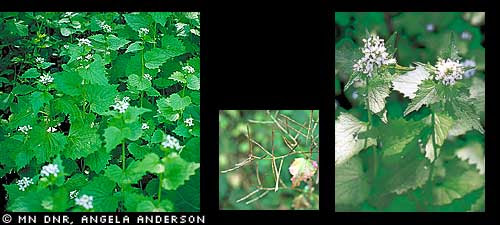Garlic Mustard, Alliaria petiolata
If you have ventured out walking the woods this week, you may have noticed clusters of small white flowers on stalks about knee high with triangular shaped leaves with large toothed margins. This plant is likely garlic mustard. There are no other white blooms that look similar at the point in our spring. The many native species currently blooming white all have large petals.
Here are a couple photos from MN DNR:

This is the right time to be pulling this extremely aggressive invader. If you can catch them in bloom you can interrupt the plant’s two-year life cycle. If their seed pods have started to form you will need to bag them for disposal. CAUTION: in wet weather, they can keep blooming even after being pulled from the earth!
If you miss this opportunity, seed pods burst to release thousands of seeds for every plant. Then you will have the chore of working for seven years to exhaust this one year’s seed production. While it is possible to kill the first year rosettes, it is easiest to pull the whole plant out of the ground as it comes into bloom. You don’t have to bend over as far and it pulls out easier than first-year plants. Why is it important to get rid of this menace? It has a chemical in its roots that inhibit mycorrhizal fungi that are essential for the health of full-grown trees that depend on a collaboration underground to extend the root system of the tree using the fungal mat. The fungi benefit from sugars that the tree supplies. Imagine a mature tree being killed by this knee-high biennial.
If you notice the plant and it is not on your property, please inform the owner that they are harboring a noxious plant. If that owner is not willing to address the problem ask for their permission to pull any plants you can find. Put them in standard paper yard waste bags and leave for your city to collect. Do not attempt to compost on your own unless you know you are achieving high temperatures in your compost heap. In my own yard, in South Minneapolis, garlic mustard showed up under our lilac at the corner of our lot next to the public walk. I assume the seed fell off someone’s shoe or a dog’s fur.
Edibility: some find the taste of the leaves to make a palatable salsa or pesto. Others find it not so great.
– Douglas Owens-Pike, Metro Blooms Sustainable Landcare Expert

